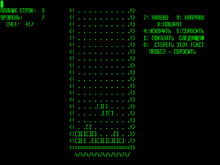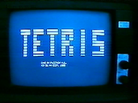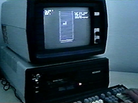Tetris (Electronika 60): Difference between revisions
Video footage! |
No edit summary |
||
| Line 2: | Line 2: | ||
|developer = N/A | |developer = N/A | ||
|publisher = N/A | |publisher = N/A | ||
|released = 1985 | |released = 1985, USSR | ||
|platform = Electronica 60 | |platform = Electronica 60 | ||
|boxart = Original_Tetris.png | |boxart = Original_Tetris.png | ||
|title-scrn = Original_Tetris_Title.png | |title-scrn = Original_Tetris_Title.png | ||
|ingame-scrn = Original_Tetris_Gameplay.png | |ingame-scrn = Original_Tetris_Gameplay.png | ||
|preview = 1 | |||
|playfield=10x20 | |||
|hold = No | |||
|hard = Yes, locking | |||
|system = [[Original Rotation System]] | |||
}} | }} | ||
'''Tetris''' | [[Alexey Pajitnov|Alexey Pajitnov's]] original '''Tetris''' was programmed in Pascal on an Electronica 60 - an unauthorized Soviet clone of a Digital Equipment Corp. PDP-11 computer. The game features monochrome graphics, and in the first revision of the game, the blocks in the [[tetromino|tetrominos]] are represented by a pair of delete/rubout characters (character code 177); however, the rendering of this character code as a rectangle was a feature specific to the Soviet clone machines, an actual PDP-11 would instead display nothing. A later revision was made where the blocks are represented by a pair of square brackets instead. | ||
==Scoring== | |||
*Points are awarded for each tetromino successfully dropped into place. | |||
**At level 0, the potential point score for each tetromino starts at '''19''', and decreases by 1 every time the tetromino descends a row due to gravity. As can be seen, an ''I'' tetromino falling freely from the top of the playfield to the bottom will descend 19 rows and score 0; it is never possible to score less than 0. | |||
**Playing at higher levels awards an additional '''3 x (Level + 1)''' points per tetromino. | |||
**Playing with the preview disabled awards an additional '''5''' points per tetromino. | |||
*3 digits are provided for score display; when 999 is exceeded, the counter rolls back to 0 and a tally of symbols appear in order to keep track of thousands. | |||
==Bugs== | |||
It is sometimes possible to manipulate a tetromino after performing a [[Drop#Hard_drop|hard drop]], even though it is supposed to be locking. Doing so will leave a trail of blocks behind, which, although visible to the player, are not recognized by the game as actually being there. This can lead to a variety of unusual scenrios, for example, visibly complete rows will not clear, and tetrominos can be dropped through the stack. | |||
==See also== | ==See also== | ||
| Line 14: | Line 29: | ||
*[[Tetris The Grand Master 3 Terror-Instinct]], where the bracket-based representation of the blocks are given tribute to in (pieces turn into brackets after the player reaches Level 1000 in Shirase mode) | *[[Tetris The Grand Master 3 Terror-Instinct]], where the bracket-based representation of the blocks are given tribute to in (pieces turn into brackets after the player reaches Level 1000 in Shirase mode) | ||
==External links== | ==External links== | ||
[http://www.youtube.com/watch?v=O0gAgQQHFcQ | [http://www.youtube.com/watch?v=O0gAgQQHFcQ Video of the game running on a Soviet DVK computer, played by Sergey Frolov] | ||
[[Category:Games List]] | [[Category:Games List]] | ||
Revision as of 00:45, 18 April 2010
| Tetris | |
|---|---|
 | |
| Developer(s) | N/A |
| Publisher(s) | N/A |
| Platform(s) | Electronica 60 |
| Release | 1985, USSR |
| Gameplay info | |
| Next pieces | 1 |
| Playfield size | 10x20 |
| Hold piece | No |
| Hard drop | Yes, locking |
| Rotation system | Original Rotation System |
Alexey Pajitnov's original Tetris was programmed in Pascal on an Electronica 60 - an unauthorized Soviet clone of a Digital Equipment Corp. PDP-11 computer. The game features monochrome graphics, and in the first revision of the game, the blocks in the tetrominos are represented by a pair of delete/rubout characters (character code 177); however, the rendering of this character code as a rectangle was a feature specific to the Soviet clone machines, an actual PDP-11 would instead display nothing. A later revision was made where the blocks are represented by a pair of square brackets instead.
Scoring
- Points are awarded for each tetromino successfully dropped into place.
- At level 0, the potential point score for each tetromino starts at 19, and decreases by 1 every time the tetromino descends a row due to gravity. As can be seen, an I tetromino falling freely from the top of the playfield to the bottom will descend 19 rows and score 0; it is never possible to score less than 0.
- Playing at higher levels awards an additional 3 x (Level + 1) points per tetromino.
- Playing with the preview disabled awards an additional 5 points per tetromino.
- 3 digits are provided for score display; when 999 is exceeded, the counter rolls back to 0 and a tally of symbols appear in order to keep track of thousands.
Bugs
It is sometimes possible to manipulate a tetromino after performing a hard drop, even though it is supposed to be locking. Doing so will leave a trail of blocks behind, which, although visible to the player, are not recognized by the game as actually being there. This can lead to a variety of unusual scenrios, for example, visibly complete rows will not clear, and tetrominos can be dropped through the stack.
See also
- Games
- Tetris The Grand Master 3 Terror-Instinct, where the bracket-based representation of the blocks are given tribute to in (pieces turn into brackets after the player reaches Level 1000 in Shirase mode)
External links
Video of the game running on a Soviet DVK computer, played by Sergey Frolov

